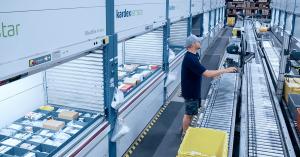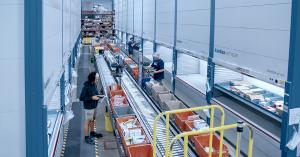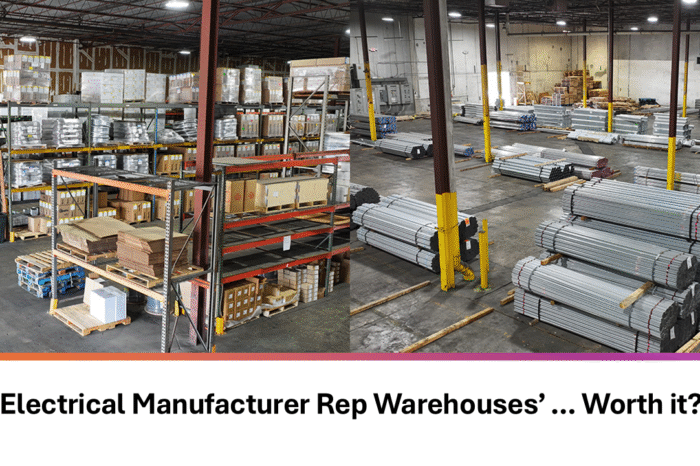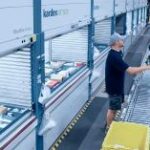Increasing Electrical Distributor CDC / RDC Warehouse Output
 With business returning to a more “normal” pace, defined as “slow growth” looking forward, leading distributors are focused on improving the operational / warehouse aspects of their business. While national chains, over the years, quickly moved to a CDC or RDC model, larger independents have also adopted this approach. This achieves a dual mandate of “improved” inventory management and operational efficiency. The goal is to reduce operating costs while improving key metrics to ensure customer satisfaction.
With business returning to a more “normal” pace, defined as “slow growth” looking forward, leading distributors are focused on improving the operational / warehouse aspects of their business. While national chains, over the years, quickly moved to a CDC or RDC model, larger independents have also adopted this approach. This achieves a dual mandate of “improved” inventory management and operational efficiency. The goal is to reduce operating costs while improving key metrics to ensure customer satisfaction.
Earlier in the week, Dick Friedman shared some thoughts on how AI should be able to further assist distributors in this area as well as some practical ideas that can be implemented today.
Van Meter, headquartered in Iowa, has 25 locations spread over 5 states, however, almost half are in Iowa. The company also operates a CDC to serve its centralized locations.
Recently the company invested in tools from Kardex and specifically their “shuttles” which are a vertical lift module (VLM) that features an enclosed shelf-based storage system.
According to a press release from Kardex,
“Van Meter is a 100% employee-owned electrical parts distributor that has been committed to providing unparalleled customer service and superior electrical products to Iowa’s contractor, commercial, OEM, systems integrators, and energy markets since 1928.
Operating out of Cedar Rapids, Iowa, their 300,000 sq. ft. Central Distribution Center (CDC) acts as the primary hub for picking and packing orders for their 12 satellite locations across Iowa and Nebraska as well as servicing over-the-counter customers and deliveries to local markets.
Growing Pains
Van Meter has grown rapidly in the past decade, with their lines picked per year increasing by 20% and peaking at over 1.08 million. Previously, Van Meter was filling orders from high bay racking (with forklifts and pallet-picking), and grey shelving (with workers hand picking products). As orders increased, the time spent walking and searching to fill orders grew, creating an inefficient process.
This growth quickly outpaced their existing space – inventory became more difficult to manage, storage space was limited, and orders became more difficult to process. Continued growth depended on a solution which better utilized existing space and increased order picking efficiency and accuracy.
Building for the Future
As part of a larger warehouse automation project, Van Meter rerouted orders via conveyor into new picking zones featuring 18 Vertical Lift Modules from Kardex Remstar. The Kardex Shuttles are arranged into 4 work zones each integrated with pick-to-light technology and Kardex Power Pick System software to enable batch picking within each zone.
Kevin Foht, Director of Operations, commented, “Space is the very first thing that comes to mind when you think about vertical storage, and the ability to utilize the full height of the facility. There are a lot of things that go into a decision about a solution like this, but the very first thing was space and planning for our future.”
Prior to implementing Kardex’s automated storage solution Van Meter used a mix of grey shelving and high-bay racking zones. After implementing the solution from Kardex, Van Meter was able to save 36 bays worth of high bay space and reduce travel distance for their associates.
Raising Throughput to Match
 With the addition of the VLM zones, Van Meter has increased their throughput by 25% – from 3,600 lines per day to 4,500 lines per day – and adding automation was the way to get it done.
With the addition of the VLM zones, Van Meter has increased their throughput by 25% – from 3,600 lines per day to 4,500 lines per day – and adding automation was the way to get it done.
On average, Van Meter’s high bay zones pick at a rate of 20 lines per hour. Their grey shelving zones pick at a rate of 50 lines per hour. Kardex zones average 65 lines per hour, with peaks as high as 100 lines per hour. Moving 2,400 SKUs from grey zone shelving into Kardex Shuttles increased pick speed by 30%+ for those items.
“When designing the system, we looked at what items we were picking the most, the receive quantity, and which items were physically suitable for totes,” said Foht, “We’ve slotted our fastest moving, highest volume products into the Kardex zones. Only 10% of our inventory is in our VLMs, but that inventory accounts for 34% of our picks every single day.”
Increasing Accuracy
Prior to implementing their warehouse automation overhaul, Van Meter boasted an impressive 99.89% order accuracy rate. Despite the high starting point, after their new conveyor and VLMs were installed they saw a 0.06% increase for a total of 99.95% order accuracy warehouse-wide. While it may not seem like a large percent increase, when applied to a 1,000,000 lines per year central distribution center it’s nearly 600 less errors per year, almost two less errors per day.
Not only did they see an overall increase in order accuracy – saving them money and securing their world class reputation for customer service – they were able to raise order accuracy specifically in the Kardex zones to 99.99%.
Doing More With Less
 Directly after the automation project, the 18 Kardex VLMs were divided into six zones with one worker picking from three machines per zone. Foht said, “Initially we saw efficiency going from shelving to six Kardex zones, but we didn’t know how efficient those zones would actually be. We eventually realized there was some downtime and were able to rearrange the existing 18 Kardex Shuttles into four Kardex zones within the Kardex Power Pick System. We are now managing picking and put away for the 18 machines with only four people, one in each zone. Phasing in these machines and reducing the total people in zones meant higher throughput, higher lines per hour, and less downtime.”
Directly after the automation project, the 18 Kardex VLMs were divided into six zones with one worker picking from three machines per zone. Foht said, “Initially we saw efficiency going from shelving to six Kardex zones, but we didn’t know how efficient those zones would actually be. We eventually realized there was some downtime and were able to rearrange the existing 18 Kardex Shuttles into four Kardex zones within the Kardex Power Pick System. We are now managing picking and put away for the 18 machines with only four people, one in each zone. Phasing in these machines and reducing the total people in zones meant higher throughput, higher lines per hour, and less downtime.”
After the warehouse automation project, the warehouse fulfillment team consists of only 19 workers, saving 21% on labor costs associated with order picking, all while increasing throughput.
Conclusion
Van Meter’s transformation from a small Iowan electrical distributor carving a name for themselves in a post-depression economy, to a 100% employee-owned company known around the region for their exceptional customer service is nothing short of inspiring.
In the face of rapid growth and rising order counts, Van Meter invested in automation solutions to solve their current issues and create an order fulfillment process built with the future in mind. Through automation, they were able to double their throughput, reduce their dependency on labor by 21%, and improve their already impressive customer service by increasing order accuracy to 99.98%.
Takeaways
- Increasing capacity, operational efficiency, reducing labor costs, improving customer service are all critical objectives for a distributor. Gathering material in a centralized location is good. Optimizing it, especially when picking over 1 million SKUs a year, is essential, especially with only 19 people employed in the warehouse!
- The stats are impressive, and as an ESOP, Van Meter is very focused on investing prudently, which provides an indication of the ROI that they expect. Further, the company is very customer-focused, so another metric most probably was “what will this do for our associates AND our customers?”
- For those with CDCs, perhaps reaching out to Van Meter to learn more about their warehouse processes and the options they considered could be helpful in optimizing warehouse operations. Information sharing is one of the hallmarks of independent distributors.























